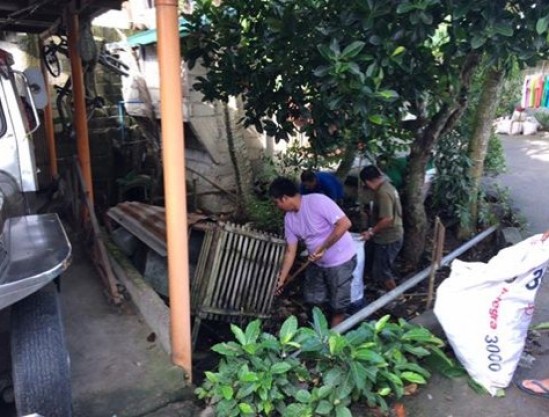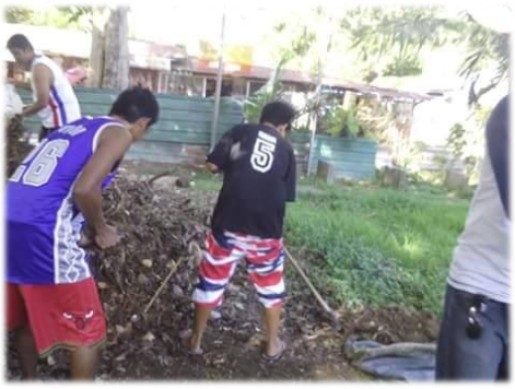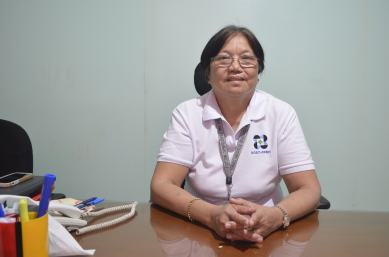by Marisha Beloro
“Nalungkot yung asawa ko dahil alam niyang wala na kaming ikabubuhay.”
Recalled Nestor Ropelo, commonly known as Bong, a 47 years old Barangay Tuntungin-Putho resident as he shared his family’s initial reaction when he decided to finally stop charcoal-making, their family’s source of income.
Mang Bong shared that he is not originally from Brgy. Tuntungin-Putho, Los Baños Laguna. He is from Mindanao but he met his wife there. They get married and settled in the place. Their marriage is blessed with nine children.
He shared that after being sick, he was not able to get any job that would sustain their everyday life and since his in-laws are into charcoal-making, he decided to turn into it. Making and selling charcoal had been his source of income in two years time. Through it, he was able to provide for his family’s daily needs and it also enabled him to send his children to school.

Mr. Nestor “Bong” Ropelo (L), a charcoal maker before, now a CFNR employee; Beside him is Brgy. Councilor Albero I. Naredo (R) previous Brgy. Environmental Head. Taken by: Marisha Beloro (February 4, 2017)
Why ban charcoal activities in the Barangay?
Pursuant to the Clean Air Act of 1999, several raids destroying illegal charcoal-making sites set-up by residents and non-residents in the baranagay have been made since 2011 up until today.
It is through the initiative of the local government unit of Barangay Tuntungin-Putho to have a charcoal free barangay due to the ill effects of the process of charcoal-making to its residents’ health and the environment.
Such raids had been done in areas such as Maria-Tuntungin Hill, parts of MFFR (Maria Makiling Forest Reserve); reaching up to DTRI (Dairy Training and Research Institute) area near the barangay because the wastes of charcoal-making done within this area are washed off to the Buot and Maitim Creeks.
According to Barangay Councilor Alberto Nareda, the former Barangay councilor heading the barangay initiatives in environment, together with Barangay Chairman Ronaldo Oñate, the main challenge aside of informing people is making them act.
Brgy. Chairman Oñate said that it is a constant effort, a collective one to continue aim for a charcoal free barangay.
“Laging katwiran [of people caught] na walang pagkakakitaan,” shared Oñate. But the raids still continue, apprehending anyone who violates. And according to him, most of the people caught are not even native residents of the barangay.
“Kahit hating gabi, madaling araw, kung may nakikita [kami] sa bundok, aakyatin namin ‘yan, guguho ‘yan eh [bundok],” he added.
The effects of charcoal-making varies from soil erosion, flooding and landslides at least to the barangay level where only small scale charcoal production is present.
But on a larger scale of production, the industry can lead and add up to forest degradation or the reduction of the ability of the forests to regenerate the consumed products of it such as tress.
The process of charcoal making
According to the 2011 Household Energy Consumption Survey (HECS), the most recent data published by the Philippine Statistics Authority last 2013, 36.4 % of the 20, 969 households surveyed nationwide consumes charcoal. From the preceding results of 34.2% on 2004, the results went up by 2.2%.
See: Philippine Statistics Authority (2013) – The 2011 Household Energy Consumption Survey (HECS)
Charcoal-making is also not very technical as compared to other fuel present. Anyone can actually do it provided that they learn the basics of charcoal production.
See: Charcoal Production
According to Mang Bong, there are two kinds of charcoal: the pabilog (circular) and the pahaba (vertical). Particularly, Mang Bong says that he can consider himself expert in producing the pabilog type of charcoal. He also said that the quantity of charcoal a person can produce depends on his/her preference.
Mang Bong shared that one common wood example used in charcoal making is Lapnis and contrary to what most people know, that any wood available can be used in charcoal making, Mang Bong said that wood like Tibig containing more liquid in its stems and trunk is not suitable for charcoal production.
Aside of being easy to produce, needing only a raw material such as tress (which are free!) and a place to do all the processes such as cooking the wood (without rent), charcoal is much cheaper than LPG (Liquefied Petroleum Gas) that costs 650+ pesos. With only 10-15 pesos, you can buy a bag of charcoal that can last according to the quantity you will use. Many families indeed turn into it since most of them cannot provide 650 pesos all at once for cooking and other home purposes.
Current barangay state on the issue
With 9,446 people residing in 6 puroks, the Barangay also came up to several programs implemented to protect the environment aside of banning the charcoal production. These includes monthly clean-up drives of Buot and Bitukang Manok Creeks, Tree-Planting Activities, and MRF (Materials Recovery Facility) where wastes are processed to asses if these wastes can still be recycled.
According to Barangay Councilor Alberto Nareda, the former Barangay Councilor super heading barangay initiatives in environment together with Barangay Chairman Oñate, the main challenge aside of informing people is making them act.
“Pinaliliwanag namin sakanila na ang pinoprotektahan natin dito yung kalikasan, ‘yun ang lagi naming sinasabi, kita mo naman yung climate change, yung talagang kapag nag-putol ka ng puno, eh ang biktima ay yung mga mamamayan din at hindi lang sila pati yung mga kamag-anak nila siyempre, damay-damay yan eh,” Nareda said.

Residents participates in the Barangay Clean-up drives in the open canals – Photo courtesy of Brgy. Councilor Alberto Naredo

Residents participating in regular bayanihan – Photo courtesy of Brgy. Councilor Alberto Naredo

Residents and Brgy. officials join hands in cleaning the barangay open canal – Photo courtesy of Brgy. Councilor Alberto Naredo
He also added that it is not enough that people in the community are aware about the projects but they also make them understand the purpose of these barangay projects that are about taking care of the environment.
Mang Bong decided to stop charcoal production as a source of living. He ventured from a lot of job opportunities for him to still provide for his family. He tried tapping on his friends asking for job openings.
People’s pulse
“Eh okay din naman, kasi yung puno napuputol, ‘pagka ano, makakalbo ang kabundukan. Kaya lang, kailangan din ‘yung uling,” said Cynthia Lawas when asked about her stand on the banning of charcoal-making in their barangay.
Cynthia Lawas, 47, has been a barbecue vendor for 10 years now. Selling variety of ihaw-ihaw along the streets enabled her to help her husband to provide for their eight children, two of her children are now in college.
“Kasi ‘pag hintayin ko ‘yung suweldo ng asawa ko tuwing katapusan, ay kulang na kulang,” said Lawas.
Lawas shared that because charcoal production is banned on their barangay, she purchases the charcoal she use at the market and she have no idea where these are produced.
For Mean Villate, 36, burger vendor just in-front of the Brgy. Hall of Tuntungin-Putho, she’s in favor of the charcoal-making ban.
“Siyempre kailangan nilang itigil ‘yun mauubos ‘yung mga puno lalo na tayo malapit tayo sa bundok,” Villate said.
Sixty-six years old Serapio Del Mundo, an e-bike driver and a resident of Brgy. Tuntungin-putho shared his insights on the ban.
“Sa pag-kakaalam ko, yung bunga niyan [Lapnis], gustong-gusto ‘yan ng ibon eh. Kaya siguro may nagdala niyan dito galling ibang bansa, ang kaso mabilis naman dumami, perwisyo sa ibang halaman,” he said.
Del Mundo added that for him, aside from some negative effects of charcoal in the environment, the threat of charcoal production is much evident on human’s health.
“’Yung init at ‘yung alikabok sumusuot sa ilong, papasok yun sa baga, maaring mag-ka sakit sa baga,” turan niya. “Kasi tinatabon jan [sa uling] lupa, ‘pag hinahango yan maalikabok e, kung masasanghap mo, pa[pa]sok sa loob ng katawan, tb abutin ng nag-uuling, kailangan may proteksyon.”
Mang Bong also shared his experience in convincing his peers to stop charcoal production, “Minsan, sasabihin sayo na, sige titigilan ko ito pero bigyan mo ako ng makain,” He added, “Sabi ko [sakanila] ay wala bang ibang mapag-kakakitaan? Ang sasabihin [nila saakin] ay sige bigyan mo ako ng trabaho.”
Expert says

Engineer Belen Bisana, Supervising Research Specialist at Biomass Energy and Equipment Development Section (Chief) of Department of Science and Technology- Forest Products Research and Development Institute (DOST-FPRDI), one threat charcoal making have for people who’s into it is the danger of inhaling Carbon monoxide (CO) contained in the smoke in producing charcoal, the said chemical is toxic to human beings.
When carbon monoxide is inhaled, it mixes with the red blood cells making it unable to bring oxygen supply in all parts of the body. It can cause tissue and organs to malfunction and can even lead to death.
According to Engr. Bisana, people who make charcoal manually should always wear the following:
- Face Mask – prevents too much inhalation of smoke which contains CO
- Googles – protects the eyes from small particles mixed in air/smoke
- Hand gloves – protects the hand for possible burn
See: Interview Highlights with Engineer Belen Bisana
“Kung talagang interested sila, pumunta sila dito sa FPRDI para turuan namin sila ng tamang paraan ng pag-uuling, para din nila malaman na other than wood ay may iba pang raw material na pwede nating ulingin and turn into briquettes. Mag-seek lang sila ng help and assistance dito sa FPRDI,” said Engr. Belen.
FPRDI conducts lectures about charcoal production, charcoal briquetting and a lot more. Any interested parties can write a letter addressed to the Technical Service Division of the institute.
The coming years
Oñate said that the barangay is always open for text and calls of complaints about the practice but ensures that the names of the informants are left undisclosed for their safety and to avoid disputes among residents and other locals since the industry doesn’t just involve solely barangay residents.
“Hanggang may nag-uuling, hindi kami titigil,” Oñate said. “Naniniwala ako na halimbawa na kung ito ay madyaryo ay siyempre ho ipinadadala ninyo kung san-san, hindi man lahat pero meron na gagaya. Dahil yung dahilan naman ng proyektong ito ay pagmumulat sa isip, maaring may gumawa. At sa oras na may gumawa ang benefit nito ay lalawak sa ibat-ibang lugar sa Pilipinas.” He emphasized.
As for Mang Bong who was one of the first residents caught in charcoal production in the Barangay, he is now helping the barangay to encourage his kababayans to stop the charcoal production in Tuntungin-Putho.
“Nasisira ang kalikasan, at hindi lang naman tayo ang maapektuhan nito kundi pati narin yung mga kababayan natin, pati narin yung mga anak natin, ganun din, sino ang mapapahamak, tayo rin, kaya kung maari lang, mag-hanap na tayo ng ibang trabaho,” according to Mang Bong.
Currently, Mang Bong is employed at the Institute of Agroforestry at the College of Forestry and Natural Resources, UPLB. He gives lecture about rubber production and he even help students writing their thesis.
“Ipinakita ko naman sa asawa ko na hindi ako tumigil..mayroon padin akong ikabubuhay kahit hindi ako nag-uuling, nakakatulong pa ako sa kapwa ko. Balang araw kung ipagpatuloy ko iyan, pati rin mga anak ko maapektuhan, kaya ngayon ay isa narin ako sa mga kumbaga, sabihin natin na nangangalaga sa kalikasan,” Mang Bong said.
